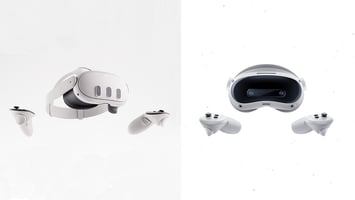Meta's CTO explains why motion trackers aren't in the cards for Quest, despite competitor...
Is the Pimax Crystal better than a Meta Quest 3?
Dive into the ultimate comparison between Pimax Crystal and Quest 3, exploring their strengths, weaknesses, and which VR headset reigns supreme.
When it comes to visual fidelity, the Pimax Crystal sets a high standard, outshining the Meta Quest 3 in several key aspects. For users prioritising image sharpness and immersive experiences, the Pimax Crystal offers significant advantages.
Resolution: A Clear Winner
The Pimax Crystal delivers a stunning resolution of 2880 pixels per eye, far surpassing the Meta Quest 3, which offers 2064 pixels per eye. This higher resolution translates into sharper, more detailed images that enhance every aspect of virtual reality.
Colour, Contrast, and Lenses
The Pimax Crystal's superior colour accuracy and enhanced contrast levels provide a richer visual experience, making virtual environments more vibrant and lifelike. The inclusion of advanced pancake lenses further enhances clarity, reducing distortions and ensuring a crisp field of view.
Refresh Rate and Hardware
The Pimax Crystal also supports higher refresh rates, providing smoother motion and reducing eye strain during extended VR sessions. Paired with Primax Sword Controllers the device ensures precise tracking and interaction, solidifying its position as a leader in XR hardware for the gaming community.
Additional Options: Pimax Crystal Light
For those seeking a more affordable alternative, the Pimax Crystal Light offers many of the same benefits at a lower price point, making advanced VR technology accessible to a wider audience.
Meta Quest 3: A Worthy Contender
While the Quest 3 holds its ground as a versatile and user-friendly mixed reality headset, it lacks in visual performance compared to the Pimax Crystal. However, the Quest 3 remains a strong choice for users who prioritise lightweight design, easy setup, and integration with a broader ecosystem of and applications in virtual reality.
Which Headset Should You Choose?
When deciding between the Pimax Crystal and the Meta Quest 3, consider your primary needs:
-
For superior visual quality and immersive realism, the Pimax Crystal is the clear choice.
-
For an affordable, versatile, and well-rounded VR experience, the Meta Quest 3 offers excellent value.
Which headset do you personally think wins the battle of VR visuals?
Standalone vs. PC VR: The Convenience Showdown

When it comes to VR, convenience plays a major role in choosing the right headset. The Meta Quest 3 and Pimax Crystal cater to vastly different user needs, each excelling in its own domain.
Meta Quest 3: The Ultimate Standalone Experience
The Meta Quest 3 is a true standalone headset, meaning it operates independently without the need for a gaming PC. This portability and wireless design make it an excellent choice for users seeking flexibility and ease of use. Whether you're gaming, exploring immersive apps, or using it on the go, the Quest 3 offers unmatched convenience.
-
Portability: Use it anywhere, anytime—no cables or complex setups required.
-
Wireless Freedom: Engage in VR experiences without being tethered to a PC.
-
Standalone Platform: Access the Meta Quest Store, offering a wide range of VR games and apps designed for standalone functionality.
-
Ease of Setup: Perfect for casual users or professionals who value simplicity.
Pimax Crystal: The Power of PCVR
The Pimax Crystal, in contrast, is a dedicated PCVR headset designed for high-performance gaming and professional applications. It requires a high-end gaming PC to fully leverage its advanced features, connecting via a wired setup for optimal performance.
-
Superior Optics: The Pimax Crystal boasts high-resolution optics and cutting-edge technology, providing unparalleled visual fidelity.
-
Enhanced Performance: Powered by the capabilities of a PCVR platform, it delivers smoother frame rates, detailed visuals, and a more immersive experience.
-
Wired Connection: While less portable, the wired setup ensures stable and consistent performance for demanding applications.
-
Pimax Store: Access exclusive titles and apps through the dedicated Pimax Store, expanding your VR library.
Audio Experience: Immersive Soundscapes in VR
The Meta Quest 3 and Pimax Crystal both deliver solid audio performance but cater to different user preferences when it comes to immersion and sound quality.
Meta Quest 3: Convenience Meets Quality
The Meta Quest 3 features built-in speakers that provide a satisfactory and hassle-free auditory experience. The speakers are integrated into the headset’s design, ensuring convenience and eliminating the need for additional accessories.
-
Audio Quality: Clear and balanced sound suitable for gaming, professional applications, and general VR use.
-
Ease of Use: No extra setup required; simply power on the headset and enjoy immersive audio.
-
Touch Plus Controllers: Coupled with precise controllers, the audio complements the tactile experience for a more engaging VR session.
Pimax Crystal: Customisable Audio for Audiophiles
The Pimax Crystal offers decent built-in audio but shines in its ability to support additional speakers or high-quality headphones. This flexibility allows users to tailor their audio experience for maximum immersion.
-
Custom Audio Options: Add external speakers or headphones for a superior soundstage, enhancing realism in VR.
-
Enhanced Immersion: Paired with its high-resolution displays, advanced lenses, and superior image quality, optimized audio creates a fully immersive environment.
-
System Compatibility: Works seamlessly with external audio setups, making it ideal for users who prioritize sound clarity and depth.
Comparing Audio and Beyond
-
Built-In Audio: The Meta Quest 3 offers integrated convenience, while the Pimax Crystal focuses on flexibility for those who prefer customizable setups.
-
Immersive Vision: The Pimax Crystal's superior picture quality, displays, and lenses enhance the overall sensory experience when paired with high-quality audio.
-
Controllers and Interaction: Both headsets feature advanced controllers—the Touch Plus Controllers on the Quest 3 and Pimax Reality Controllers—that integrate with their respective audio systems for a seamless VR experience.
Final Verdict
-
The Meta Quest 3 is perfect for users seeking a plug-and-play system with built-in audio that works effortlessly for all kinds of applications.
-
The Pimax Crystal is ideal for audiophiles and users who want to invest in a customizable sound system to pair with its stunning visuals and high-performance specs.
Tracking and Controllers: Precision in Motion
When it comes to immersive VR experiences, tracking and controller functionality play important roles in how users interact with their virtual environments. Both the Meta Quest 3 and Pimax Crystal offer advanced tracking systems, but there are key differences in their capabilities and controller designs.
Meta Quest 3: Accuracy and Convenience
The Meta Quest 3 stands out for its ease of use and tracking accuracy. The headset uses advanced inside-out tracking technology that requires minimal light to maintain precise space tracking. This makes it well-suited for users in various environments, from bright rooms to dimly lit spaces.
-
Tracking: The Quest 3’s inside-out tracking system ensures that your movements are captured with high accuracy, delivering a smooth and stable experience without the need for external sensors.
-
Controllers: The Quest's controllers are powered by AA batteries, which are easily replaceable. While this might be less convenient than rechargeable controllers, it ensures you can quickly replace the batteries when needed, keeping the experience uninterrupted.
-
Convenience: The Quest 3 offers a streamlined, simple experience, making it ideal for users who prioritize ease of use and minimal setup.
Pimax Crystal: Superior Tracking Precision
The Pimax Crystal takes tracking to the next level with its more advanced and powerful capabilities. Constant software updates ensure that the tracking system becomes increasingly precise, offering an edge in terms of responsiveness and accuracy. For users seeking the most immersive and precise tracking experience, the Pimax Crystal stands out.
-
Tracking: The Pimax Crystal boasts enhanced tracking technology, providing more responsive and accurate movement detection. Its external sensors and advanced algorithms deliver superior performance in larger spaces, where the Quest 3 may not be as effective.
-
Controllers: The Pimax Reality Controllers are rechargeable via USB cable, which some users may find more convenient than constantly replacing AA batteries. The rechargeable design also aligns with the Pimax Crystal's emphasis on premium features and sustained performance.
-
Picture Quality: Along with superior tracking, the Pimax Crystal provides exceptional picture quality, further elevating the immersive experience. When paired with its high-resolution displays and superior optics, the tracking system ensures that every movement is accurately reflected in the virtual world.



